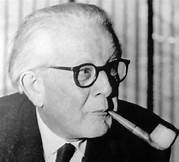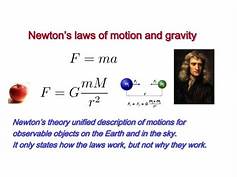The physicist David Deutsch.
I learn something each time I listen to this guy-its ridiculous.
His writings and presentations really exemplify and explicate the SSP-Secular Scientific Perspective, especially with regards dropping old mythological explanations for how the world works – to adopting “hard to vary” good explanations: theoretical, natural, scientific explanations. A wonderful TED talk.
Long before the scientific revolution of theoretical explanation and understanding, the human brain evolved the ability to do explanations, but for at least 500,000 years only took explanation to a heuristic, surface level, empirical rule-of-thumb stage, with little understanding of underlying processes. Living by our wits, concocting notions: surface-level heuristics, and storing that knowledge in memory and passing it on in culture – and for millennia, unwritten. It was carried all in our heads, and often stored in ritual form to maintain the precise knowledge.

Think of the Japanese Samurai sword manufacturing – all done in precise ritual steps as they had no way to measure the proper temperatures. So they sang hymns, or recited prayers that gave the fire the right time to heat the steel. Or consider the Gothic stone masons and early pyramid and stone temple builders possessing only simple surface knowledge (literally): how to mate one surface to another, stack one block upon another – with no underlying knowledge of strength of the stone, the forces, or atomic structure that gave it strength and kept it from falling. Pure trial and error, empirical, knowledge.
And with us humans, it starts early: discovering regularities in how the world works.The infant brain starts to detect patterns and build heuristics in the first year of life. Additionally, the infant also builds concepts – conceptual knowledge of things, and at a surprisingly abstract level, from the gitgo. Although the child won’t learn equations such as 2+2 for a number of years, the baby’s brain is implicitly doing probability statistics on natural occurrences long before that.

And even though it took millennia to get to the sort of scientific explanations that are not mythological, but naturalistic in content, the human animal sought explanations, however primitive and basic, since well before the modern human species (us-H. sapiens) appeared nearly 300,000 years ago. We seek how to fix things, make things better, keep ourselves warmer, better fed, better sheltered. Humans approach the world as full of little, nearly continuous problems to be solved. And it starts with each of us when we are very young.
Consider the very abstract concepts of support, propulsion, and containment. In the first year of life, these spatial-force implicit concepts develop without any teaching, without guidance of any kind, merely from your child interacting with the world and its objects.

Although Jean Piaget, the Swiss psychologist and Father of Developmental Psychology underestimated some of the mental capacities of the infant mind, he did explicate how they operated as little scientists in the world, building their knowledge through observation and interaction with objects and people. These conceptual advances of support, propulsion, and containment were investigated and described after Piaget, but are right in line with his observations of the abilities of children experimenting with objects in their world. I think he would have been amazed by the detail of infant knowledge discovered by subsequent research building upon his ideas.
There is no explicit conceptual knowledge of these concepts for the child until much later in life-taught in late grade school and high school at the earliest. When in human evolution or human history-did we make the jump from implicit to explicit? Was it in the hypothesis-test skill of the earliest animal trackers? Was it to come much later in the naturalistic theoretical attempts of the Pre-Socratic Greek thinkers: Thales, Anaximander, et al.? Was it only until the Scientific Revolution beginning in the 1600’s that explicit understanding became the norm in explaining the world when we may have had the capability for centuries or millennia before?
From repetition with objects – as in my 11 month-old grandson’s fascination with knocking down the towers of mini-spice jars I stack for him just out of his reach – kids learn what objects usually do. He frantically walks his way around the coffee table, holding onto the rim as he is just learning to walk and hasnt taken steps on his own yet – and he is so excited, compelled, obsessed almost, to get them in his reach and knock those suckers down. He loves it, eats it up. He sees them fall onto and some off the table and onto the floor, and he is delighted! Nobody taught him this, he gets excited about object properties all on his own, as does every human child.
Your dog doesn’t do this. No chimp does this. The cleverest crow and the most spatially competent maze-champion rat doesn’t do this either. Only the human animal does this.
And like other infants his age he begins to implicitly understand support, his brain catches on to this abstract concept that applies to all objects-they don’t float out in midair, they sit on things, on substrates like tables and floors and couches and beds. They sit on one surface or another, on top of each other and if not supported: they fall, they fall off and land on another surface. They fall without support. They sit there with it. ALL objects do this and the 1 yr. old experiences this pattern with objects daily. He reaches out and knocks his pacifier off the edge of the car-seat, he purposely throws his bottle off of his high chair table and watches it land and roll and stop, supported by the floor now. He stacks blocks later in his second year and watches them tumble if he isn’t careful in placing them properly one atop the other.
Chimps never get this.

This knowledge is implicit. The child’s brain knows blocks will fall if unsupported-maybe we knew we had to stack things properly 100’s of thousands of years ago or they would fall off, but it took until 1687 and the publication of Isaac Newton’s Principia Mathematica before we had any theory of, and precise description of gravity: explicit theoretical knowledge of underlying objects and forces explaining how and why objects fall when unsupported. And the young child first learns the simple facts of gravity-explicitly- some time in grade school-and may only hear of Newtons Law of Universal Gravitation and see the equation sometime in high school, and never really be exposed to it unless they take a college physics course.

Propulsion.

Objects don’t move under their own power. They must be kicked, thrown, pushed, – propelled in some way. They don’t get up and walk away on their own, under their own power – they just sit there until you do something to them. Infants in the first year notice this regularity. They react strongly when shown impossible events, such as objects taking off without being pushed or shoved.
Containment.
Toddlers abstract the concept of things being “in” something else across widely dissimilar situations that have no resemblance to one another. The juice isnt “in” their cup, the toy isnt “in” the toybox, and mommy walked out and isnt “in” the room anymore-and the child can raise their hands in the ubiquitous “allgone” gesture-signifying “its not here” and “I don’t know where it (she) is”.

This is a HUGE conceptual leap that your 2-3 year old has down cold, and your dog is completely clueless to, as are all other animals. Abstracting containment (or lack thereof), across perceptually dis-similar situations is a developmental milestone every child reaches without instruction. The child gravitates to naturalistic explanations, albeit implicit for the vast majority of its development. The child does not suppose non-natural or super-natural explanations. Piaget was right, the young child acts more like a scientist than a theologian.
Later around age 4-5, children begin to develop the idea of agency: that some person-like entity must be causing some unseen things. Noises they don’t understand in the night, become monsters under the bed, or something in the closet. Yet even then, they don’t begin to also suppose such explanations for any of the object properties and events they witness in their daily interactions with all the things in the world. When the block falls they don’t assume “they” did it – that some person-like thing did it, even after the age of agency and “monsters under the bed”. The child remains as Piaget described: acting as a little scientist.
It is only rather late in human history with the beginning of mythology and supernatural explanations, that the tendency to agency became the norm in explanation for how the world works. The earliest myths date to 2,000-2,500 BC with the Egyptian Pyramid Texts, and the Sumerian Epic of Gilgamesh. The Hindu Vedas date after 2,000 BC, and the later religious stories and mythological explanations from the Bible and those of Greek and Roman Mythology date well after 1,000 BC. There was a fair amount of early science going on during this 3,000 year period, with the first attempts at naturalistic explanations offered by the Pre-Socratic Greek philosophers in the early first century BC, and continuing thru much of Classical Greek and Roman times, but it was very much under the radar for most people. Subsequently, science took a real back seat to religion and mythological explanation during medieval times. They weren’t called the Dark Ages for nothing. Mythology had a pretty good run, but is now significantly diminished, even for the average person, as compared to science when it comes to explanation.

Yet, the world’s religions still cling to myth as explanations – unseen person-like agents ultimately rule our fate, must be worshiped, and properly, to secure a good life or any chance of an after life. Sinning against one of these gods brings you misery in this life and eternal torture in the next. Babies never think of this.
Curiously, today’s outlandish conspiracy theories held to steadfastly only by a minority of the strongly religious, contain many of the mythic elements of old: a pessimistic view of impending disaster just around the corner, with an evil cabal of unseen agents conspiring behind the scenes to get us all, possessing supernatural abilities to accomplish their dastardly schemes and global control. Chem-trails have replaced comets as omens of disaster on the horizon, pizza parlors have become dens of iniquity.
Anyone who does science, understands and respects science, doesn’t fall for these silly, utterly absurd and outlandish plot twists and turns – they know the world doesn’t work that way, only imaginary gods and devils do. Anything goes in mythology, and the overly religious of the 21st century have replaced Zeus and the Devil with scheming political rivals – working behind the scenes to destroy world order by one dastardly progressive, socialist scheme or another – and selling off our children into sex slavery, blood sacrifice or gender oblivion.
Deutsch, on the hegemony of mythological explanation among the ancients:
“They even arrived at answers, such as myths, that dominated their lives, yet bore almost no resemblance to the truth”
Thankfully, such early attempts to explain the world that truly bear no resemblance at all to how we now understand the world, do not dominate our lives as much as they once did. Science has taken over in much of our daily life, but mythology in religion still holds entirely too much sway, and is the cause of much or our remaining strife in the modern world.

My FAV bumper sticker…
Mythological explanations, full of imaginary agents, gods of this and that, became the dominant way to explain how the world works for only that short period of human history, thankfully, roughly 5,000 or so of our nearly 300,000 years of existence as modern humans, and began to give ground to naturalistic theory – with no gods anywhere, by the time of the Renaissance and Enlightenment. Since the subsequent Scientific Revolution, mythological explanations have been discarded wholesale for understanding the world, by the scientific community at least, and by much of the larger public, who are incomparably less religious than their counterparts prior to the Enlightenment, Age of Reason, and the Scientific Revolution.
Deutsch once again;
“They believed that knowledge came from authorities, that actually knew very little. And therefore, progress depended on learning how to reject the authority of learned men, the priests, traditions and rulers…”
And only the world’s religions still cling to that archaic and utterly wrong idea: Phony authorities. Which are mostly old men in funny costumes and unique, if not comical headgear… who are only “learned” in one sense- that is, educated in the ways and history of their particular religion, and not modern science. I’ve been saying that for years. It has been some real conceptual validation to hear Professor Deutsch reiterate that so succinctly. In science, there are no authorities, who just by fiat can command how the world works. They don’t talk to god like the Pope and Mormon Presidents claim to be able to do, once properly elected.
There are experts in science as in any other field to be sure, who do phenomenal work, but even they can be wrong and are trained to be the first to admit to it. And as much as that may be difficult for those of strong personality and drive in any profession, in science it is the norm.
We have come a long way from simple implicit, un-theoretical habits and rules of thumb however clever, that we seem to be wired as infants to develop. We have progressed to a world where in the 21st Century there are over 10 million scientists employed, who are investigating nearly every aspect of our existence. We are moving away rapidly from myth-and none too soon. Each generation becomes more realistic and non-religious – and this has been going on for centuries now. We are using our implicit abstraction abilities to now build explicit theories to a unprecedented scale here in 2020’s. All the other animals, do neither of these.
How did that qualitative split from all other animal cognition evolve is what I really want to know. And it is a qualitative difference. From mere categorical perceptual similarity that the animals employ, to the staggeringly significant and effectual conceptual relations and ultimately: theoretical explanations. But that is the subject of later essays and hopefully another book down the road.
Animals build categories that lack the causal, force, or spatial relations that human infants develop effortlessly, relying on perceptual similarity only: cats all resemble cats and not dogs, people look different than squirrels (some of them at least), but dogs are easily fooled by the statue of a person or a critter that resembles a live one.

No understanding at all of live or dead, or of support, containment, or propulsion, or any other abstract relation or concept.
Infants are wired to build on perceptual categories from the start, to see similarities, and then add in spatial and force relations like support, containment, and propulsion, and to form concepts that has members with little to no perceptual similarity such as:
Living vs non-living.
This early concept is built on two characteristics the infant observes in the objects and people around him: self-movement and reactivity. Objects do neither. They just sit there, they never move on their own (propulsion is required), and they never respond no matter what you do to them. And they (non-living objects) look utterly different from one another: a ball and a chair and their sippy-cup, all non-living things. And Mom and kitty and big sister (definitely alive) look rather different as well, but move about on their own (not needing to be propelled) and react to stimuli. Dogs and chimps and rats and crows don’t make this distinction. Mother chimps are known to carry their dead infant around for days, weeks, until through lack of nursing their nurturing hormones wear off and they go back into estrus, and finally drop the dead infant like a sack of potatoes. End of story.
As Deutsch points out we “explain the seen in terms of the unseen” and the more we delve into the deeper layers of nature’s processes, the farther away from directly visible evidence of abstract concepts we move. Our unseen things are not the gods of old.

For example, observing that the position of the planet Mercury was slighted displaced- just as Einstein predicted it would be, during the solar eclipse of 1919, supported his hypothesis of spacetime curvature: that the large gravitational mass of the Sun would bend the light reflecting off Mercury. This confirmation of Einstein’s General Relativity theory, was a prime example of a theory-laden perception.Dr. Deutsch points out that we cant actually see space-time itself, nor its curvature, only evidence for it in the change of Mercury’s postion – as predicted in Einstein’s General Relativity Theory. We can “see” instances of support, propulsion, and containment, and abstract their spatial and force relation similarities from them – but we cant see the curvature of space-time. This level of abstraction is part and parcel to modern science’s explicit theoretical understanding, built upon the infant’s early implicit conceptual abilities.
Animals and us have predictive categorical perception based on visual and other sensory similarity: we both expect things that look like cats to act like cats, but we have added on to that with theory-laden explanations, based on underlying, unseen causal spatial and force relations. All this is a direct extension of the implicit conceptualization of the developing child. Causal and spatial relations are abstract and not often perceptually similar. Mom’s movement around the room is different from Kitty’s movements, or a fly’s moving about, yet they are all instances of the concept of movement, which further underlies a nascent, implicit concept of “living thing” which only later will the child be taught explicitly what that means. And it is explicit theoretical knowledge that has given us our 21st century of smartphones, tablets, and laptops, which can access damn near ALL of that conceptual theoretical knowledge in an instant.
And that fact leads to another of my goals, to grok fully what is happening with this incredibly expanding, open-ended, stream of theoretical knowledge:
Just how big and complex in detail is modern science investigation, and what changes in our way of looking at the world might that accessible knowledge further bring about?
21st century science is a juggernaut few commentators speak about in scope or effect. Not any of my science education heroes: Richard Dawkins, Neal DeGrasse Tyson, Bill Nye the Science Guy, Lawrence Krauss, Deutsch himself, Sean Carroll, Steven Pinker, Matt Ridley…not nobody, not know-how… no-one I know of has described what the possibly 10 million working scientists are up to and might discover in the next 5-10-50 years. Nor what the impact of all that scientific advance and the knowledge thereof may be.
Myself NOT being a pessimistic, doom-saying, apocalyptic, mythological thinker, I subscribe to the Rational Optimism that the Secular Science Perspective leads to. Science has produced our comfortable, largely disease-free, sanitary, and abundant global modern world – full of freedoms and comforts that most human beings who ever lived couldn’t even begin to imagine, yet here we are.
So I am excited about jettisoning even more religious thinking, dropping ALL mythological explanations into the dustbin of history where they belong, and analyzing just what modern science is working on and what we might expect in the future. It is probably not flying cars, or any of the other silly ideas the offered in the past, nor the doom and gloom predictions of the futurists out there who not only get things wrong, but never seem to predict what is going to come down the pipe, such as: lasers, the net, smartphones, ancient DNA gene analysis, routine genetic mapping, texting, chip card banking, etc., etc., etc.
While religions continue to teach and parse their mythological delusions, the secular scientific community will continue to try to make life better for us all. And figure a few more things out-and maybe a whole lot more that we cant even imagine, just like has happened again and again since the Scientific Revolution and the rise of theoretical explanation.
end religion now.
(171)
